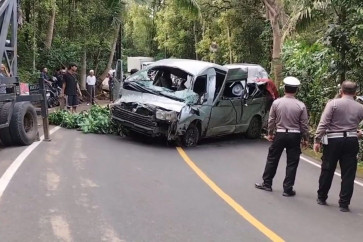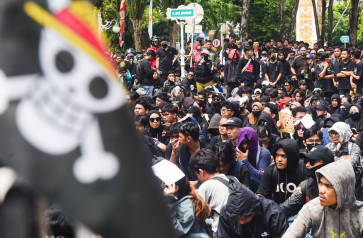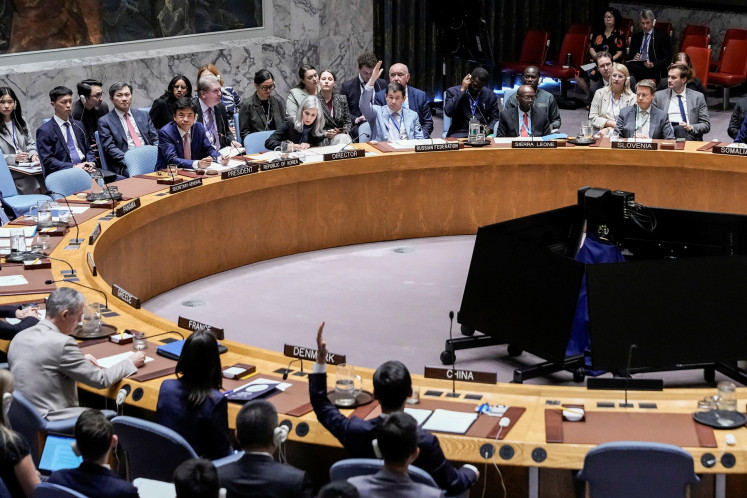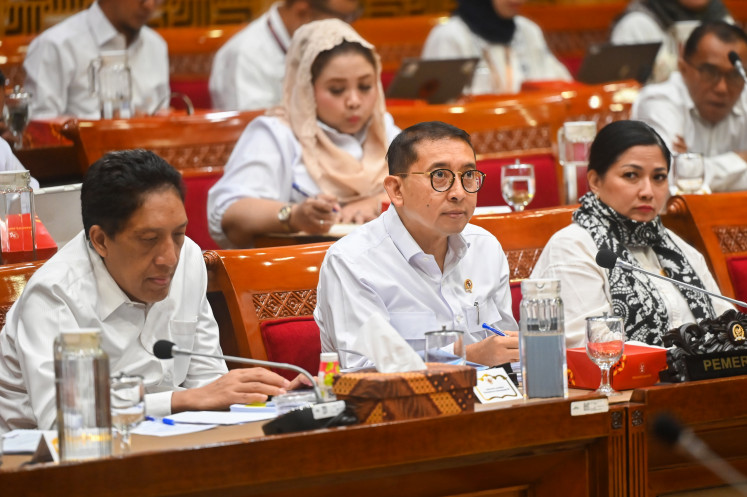Popular Reads
Top Results
Can't find what you're looking for?
View all search resultsPopular Reads
Top Results
Can't find what you're looking for?
View all search resultsThe history of sugar and more
New shape: The “Sugar Town, Inc
Change text size
Gift Premium Articles
to Anyone
New shape: The “Sugar Town, Inc.” exhibition takes the form of a grocery store and coffee shop.
Entering the exhibition room at the Kunstkring Gallery in Jakarta, “Sugar Town, Inc.” visitors find that they are not just looking at photographs.
Instead, they find history in the warm, familiar setting of a grocery store selling merchandise and memorabilia.
The exhibition is derived from an open-source photography project initiated by Noorderlicht — a photography institution based in the Netherlands. The project, “The Sweet and Sour Story of Sugar”, covers diverse elements of the sugar industry in the Netherlands and its former colonies: Suriname, Indonesia and Brazil.
Just like the Langgeng Art Foundation (LAF) in Yogyakarta, ruangrupa was given access to all the artistic material provided by Noorderlicht: hundreds of colonial photographs compiled from archives in Europe, and hundreds of new photographs by six photographers commissioned by Noorderlicht to capture current sugar industry conditions.
Aside from being able to use all the artistic material available, both LAF and ruangrupa were free to re-contextualize and add new works from local artists to better fit their own, local perspective of the once thriving industry.
Freedom was given, and ruangrupa was not going to take it for granted. While the curators at LAF presented a handful of photographs and displayed them in an old-fashioned photography exhibition, ruangrupa have taken the open-source formula to a different level.
They transformed old photographs into new illustrations and murals — done by Aprilia Apsari and Saleh Husein — which were then applied to various souvenirs and memorabilia created by Rio Farabi.
Ruangrupa also held a workshop conducted by the coordinator of the Video Art Development Division of ruangrupa, Mahardika Yudha, in which six young artists interacted with the same ingredients and produced new works in the form of videos and films.
What is also interesting is that most of the artists involved in the exhibition were young and did not have any background knowledge to shape their ideas about the issue.
All the new works are displayed hand in hand with the photographic materials. Ruangrupa said in a statement that the selected photographs focused on archives that represent the issues encountered by Indonesia, such as land and natural resources, science and technology, the mobilization of human labor and its relation to global migration, cultural heritage and the patterns of people’s consumption. Most of the photographs appear in the form of postcards — popular mass culture products — and were shelved or affixed to the walls.
Several archive photographs were printed larger or even framed, and seemed to serve as a “title” for the respective section.
For instance, there was one section in the corner of the store with several archive photos printed as large as A4 paper depicting administration workers at their desks and a landscape of a sugar factory.
Right beneath them were approximately a dozen of Alejandro Chaskielberg’s color photographs showing the abandoned sugar factories at night. Chaskielberg left the shutter on his camera open for more than 30 minutes while taking the photographs, using moonlight and lanterns to provide enough light and at the same time giving the images an enigmatic eerieness.
That juxtaposition illustrates how the works in this exhibition, coupled with the interior colonial style of the gallery, could easily emphasize the sense of history in progress.
All the juxtaposition done by ruangrupa was carefully constructed to show us this — various stories on the sugar industry as it was and as it is now creating a thorough comparison.
Using popular media to present ideas in exhibitions is not uncommon for ruangrupa, as they are known to frequently do that to garner a wider public.
“This method also serves to prolong the story of the sugar industry so it does not stop at this exhibition,” said Julia Sarisetiati, one of the acting curators of the project.
Despite being very effective for that purpose, this method has several disadvantages. The use of postcard-sized photographs requires visitors to be at a certain distance from the photographs, but the merchandise and other products were on the floor, blocking one from doing exactly that.
Also, there were too many photographs, making it almost impossible to look at each photograph in turn. What one could perceive was dozens of photographs as one big section about a specific issue, depicting the big picture of a course of time.
Sweet: Murals at the exhibition are derived from the colonial photo archives.
One can only assume that these disadvantages were intentional, that ruangrupa actually wanted the audience to see just that — the bigger picture, instead of the details — just like what the curators at LAF had done.
It was also atypical the way they presented the documentary photographs done by the six assigned photographers. Documentary works are bound to give details about a certain subject — and sometimes they can also reveal other hidden stories. This exhibition — in the form of a grocery store and using popular media — presents centuries-old history in laidback and simple, if not banal, surroundings. As it is easier for the public to access the story outside of this exhibition, it might have been as easy for them to forget the main context to be told.
Beyond all that, it was a good decision for ruangrupa to chose the Kunstkring Gallery as their exhibition space. The building, in existence since the colonial era, has the exterior and interior style that can easily contribute to creating the right atmosphere and mood to tell stories about the sugar industry and its history, and how it has shaped Indonesian society.
The colonial style of the building merged with the exhibition presentation creates an emphasis on the external context of these works, a strong nostalgic sense, a sense that otherwise would have been less easily evoked by merely looking at old photographs.
— Photos By Irma Chantily











